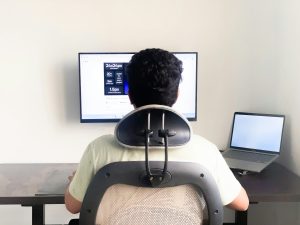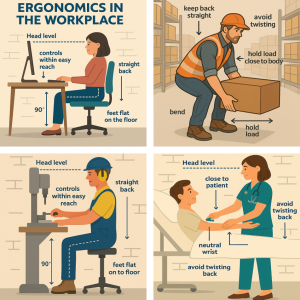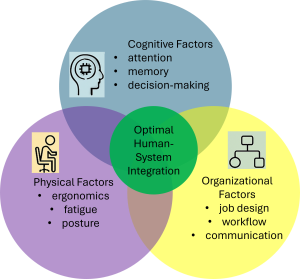9-1: Fundamentals of Human Factors
 You’re sitting at your desk, hunched over your laptop, squinting at a screen that’s way too bright, trying to figure out why the new company software seems designed by someone who clearly never had to use it. Sound familiar? Well, you’ve just experienced what happens when human psychology gets ignored in workplace design.
You’re sitting at your desk, hunched over your laptop, squinting at a screen that’s way too bright, trying to figure out why the new company software seems designed by someone who clearly never had to use it. Sound familiar? Well, you’ve just experienced what happens when human psychology gets ignored in workplace design.
This module is all about changing that story. We’re diving into how psychological principles can transform the design of work systems, tools, and environments — especially now that artificial intelligence is reshaping everything we thought we knew about work. At the heart of this transformation is something called work design, which is basically the art and science of organizing tasks, activities, and responsibilities so they actually work WITH human capabilities instead of against them.
Here’s the thing — as work becomes more complex, more dependent on technology, and increasingly enhanced by AI, understanding how humans tick becomes absolutely critical. You’re going to explore how our capabilities and limitations should inform workplace design, including fascinating topics like cognitive workload (how much your brain can handle), attention and vigilance (staying focused when you need to), human-computer interaction (making technology actually user-friendly), and physical ergonomics (designing spaces that don’t destroy your body).
But here’s what makes this especially relevant for you: AI isn’t just coming to the workplace — it’s already here, and it’s transforming everything. Whether you’re planning to work in psychology, business, technology, or any field really, you’re going to encounter AI tools, AI-enhanced processes, and questions about how AI impacts human well-being. Many of your future clients or colleagues will have concerns about AI’s impact on their careers, workplace autonomy, or job security. Understanding human-AI interaction isn’t just academic — it’s essential knowledge for navigating and succeeding in the modern workplace.
Defining Human Factors and Ergonomics
Let’s start with the basics. Human Factors (also called Ergonomics) is both a scientific discipline and a profession that focuses on understanding how humans interact with other elements of a system. Think of it as the field that asks, “How do we make work fit the human, instead of forcing the human to fit the work?”
You might be thinking, “Isn’t that just common sense?” Well, you’d be surprised how often this gets ignored! Human factors draws from psychology, engineering, physiology, and computer science to create designs that are actually user-friendly and efficient. This directly connects to work design — the application of sociotechnical systems principles to create jobs and work processes that boost both organizational efficiency and employee well-being.

The field breaks down into three main areas:
Physical Ergonomics deals with how your body interacts with physical tools and workspaces. This includes things like whether your chair supports your back, if your keyboard is at the right height, and whether the lighting gives you a headache. It’s concerned with human anatomy, physiology, and biomechanics as they relate to physical activity.
Cognitive Ergonomics focuses on mental processes — perception, memory, reasoning, and motor responses as they affect how you interact with systems. Ever wonder why some apps are intuitive while others make you want to throw your phone? That’s cognitive ergonomics in action (or lack thereof).
Organizational Ergonomics looks at the big picture — optimizing entire sociotechnical systems, including organizational structures, policies, and processes. This addresses macro-level issues like communication, teamwork, work design, and quality management.


Key Principles of Human Factors
These principles are applied across various domains to ensure designs are intuitive, safe, and effective — and they directly inform human-centered work design.

Cognitive Workload
Cognitive Workload refers to how much mental effort a task requires. Think about the difference between scrolling through social media (low cognitive workload) versus trying to solve complex math problems while someone’s talking to you (high cognitive workload). Human factors aims to optimize this — preventing both overload (which leads to errors, stress, and fatigue) and underload (which leads to boredom and reduced vigilance). The goal is simplifying tasks, providing clear information, and automating routine processes to manage mental demands effectively.
Attention and Vigilance
Attention and Vigilance are critical for tasks requiring sustained focus. Have you ever tried to proofread a document for hours? Your attention starts to wander, and you miss obvious errors. Designs should minimize distractions, provide clear signals, and support people in maintaining alertness over long periods. Control room interfaces, for example, are designed to highlight critical information and reduce irrelevant stimuli to help operators stay vigilant.
Human-Computer Interaction (HCI)
Human-Computer Interaction (HCI) focuses on designing computer technology that emphasizes user interfaces and user experience. The principles include consistency (things work the same way throughout the system), feedback (the system tells you what’s happening), error prevention (making it hard to mess up), and user control (you can undo mistakes). Effective HCI ensures that software and hardware are intuitive and efficient, reducing frustration and errors.

Physical Ergonomics
Physical Ergonomics concentrates on the physical aspects of work — workstation design, tool design, and environmental factors like lighting and noise. The goal is reducing physical strain, preventing musculoskeletal injuries, and enhancing comfort. This involves proper seating, adjustable desks, and tools that actually fit the human hand instead of making you contort into uncomfortable positions.
Usability
Usability is a key outcome of human factors design. It refers to how easy it is for users to learn a system, how efficient it is to use, how memorable it is, what the error rate is, and how satisfied users are with it.
Historical Foundations
You might be surprised to learn that ergonomic principles have been around since ancient times — there’s evidence of ergonomic thinking in tools and workplaces from Ancient Greece. But the field really took off during the Industrial Revolution, when early efforts focused on optimizing physical labor and machine design.
Pioneers like Frederick Winslow Taylor (known for scientific management) and Frank and Lillian Gilbreth (famous for time and motion studies) laid early groundwork by analyzing work processes for efficiency. You might have seen the classic film “Cheaper by the Dozen” — Frank Gilbreth was the efficiency expert father in that story, always timing his kids and looking for ways to optimize family life!
The field gained serious momentum during World War II. As military equipment became increasingly complex — think aircraft cockpits and radar systems — human errors occurred even among highly trained personnel. This highlighted the critical need to design equipment that matched human capabilities and limitations rather than expecting humans to adapt to poorly designed systems. Psychologists and engineers collaborated to address these issues, laying the groundwork for modern human factors.
After the war, these principles were applied to civilian industries, leading to improvements in industrial design, aviation, and consumer products. The term “ergonomics” itself was coined in 1949 by Hywel Murrell in the UK.
Theoretical Foundations of Work Design
Understanding human factors requires knowledge of the theoretical frameworks that guide effective work design. Several key theories inform how we structure jobs and work processes to optimize both human well-being and organizational effectiveness.
Job Characteristics Model
The Job Characteristics Model developed by Hackman and Oldham (1976) identifies five core job dimensions that contribute to meaningful work: skill variety, task identity, task significance, autonomy, and feedback. This model suggests that jobs designed with these characteristics lead to higher motivation, satisfaction, and performance while reducing absenteeism and turnover.
Sociotechnical Systems Theory
Sociotechnical Systems Theory, pioneered by Trist and Bamforth (1951), emphasizes the joint optimization of social (human) and technical (technology) systems. This approach recognizes that organizational effectiveness depends on how well human and technological elements work together, rather than optimizing either in isolation.
Work Design Research
Contemporary work design research has expanded beyond individual job characteristics to include broader organizational and environmental factors. This includes consideration of team dynamics, organizational culture, technology integration, and external market pressures that influence how work should be structured.
Media Attributions
- Man at Computer © Zesan H is licensed under a Public Domain license
- Ergonomics in the Workplace © Jay Brown and Copilot
- Three Domains of Ergonomics © Jay Brown and Copilot
- Core Components of Human Factors in Work Design © Jay Brown
- Cognitive Workload Optimization Loop © Jay Brown & Copilot
- NIOSH Logo © National Institute for Occupational Safety & Health is licensed under a Public Domain license
